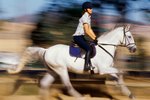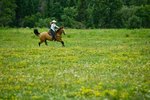
If your horse takes off at a fast pace when you ask him to trot, it's probably because he thinks that's what you want him to do. It takes subtle communication and a whole lot of practice to teach him a new speed. He may not understand what you are asking in a single training session, but eventually he will learn to read the cues you give him to slow down.
Fence Line Transitions
Ask your horse to trot along a fence line or trail with consistent markers. Let him get in two or three strides, or a certain number of fence posts that you decide in advance, and then ask him to slow down to a walk. Repeat the trot then walk sequence, letting him trot a little bit farther each time. Then begin asking him to return to a walk only when he starts trotting to fast. Repeat the process going the other direction.
Bending
Bend your horse's nose slightly toward your knee, or turn in a large circle while practicing the trot. This makes it harder for your horse to move fast. Flex his neck on the ground for several minutes before riding so that he will be responsive to your rein cues and understand what you are asking him to do. If a large circle doesn't slow him down, try riding in smaller circles until you achieve the speed you want. After he is relaxed and understands the correct pace, trot him in a straight line and bend his neck slightly or start working in circles any time he speeds up without being asked.
Change Directions
A straight run encourages your horse to test his speed. Changes in direction, on the other hand, encourage a slower or steady pace. It also keeps your horse's mind occupied since he won't know exactly where you're headed. Weave around weeds or cones in a random pattern, making slow, gentle turns. If you don't have any obstacles to weave around, pick certain points on the ground and randomly change direction as you pass the points. Don't turn sharply, but keep your horse busy enough wondering what you're going to ask him next that he isn't concentrating on moving faster.
Half Halts
Half halts or "checks" work well on horses who are responsive to rein cues. Ask your horse to trot. When he speeds up or is going too fast, lift up the reins and apply gentle pressure by pulling back slightly just after one of his front legs hits the ground, or during the moment of suspension. Release the pressure as soon as he slows down even a little bit. Don't bring him to a complete halt, but help him understand that when you lift the reins you are asking him to slow down.
References
Photo Credits
-
Jupiterimages/Pixland/Getty Images



